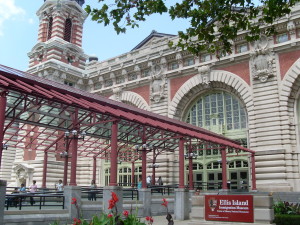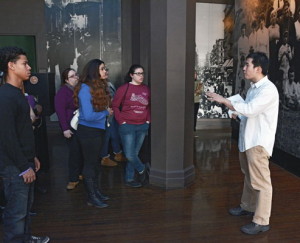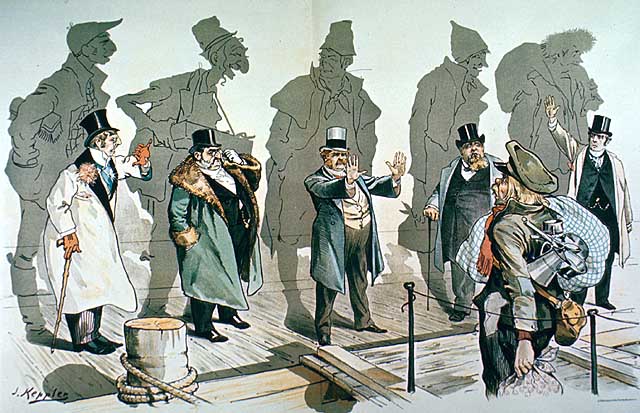Recent Articles
- Weekly Roundup, December 19th June 25, 2015
- Weekly Roundup, December 12th June 25, 2015
- Weekly Roundup, November 28th June 25, 2015

by Peter Wong, Park Ranger, Ellis Island Immigration Museum
Mainstream American society considers me affectionately as an “ABC,” or “American-born Chinese.” Native-born Chinese, meanwhile, refer to me as a “juk sing,” or “hollowed bamboo” — a derisive term indicating that while I may look outwardly Chinese, I lack the language or cultural insights to be accepted into Chinese society. To be fair, I cannot read or write Chinese, and I speak the Chinese dialect of Cantonese like a precocious nine-year-old. This scenario makes conversing with my parents difficult because they, to this day, barely speak English. Invariably, our discussions often turn into a mish-mash of broken Chinese, broken English, and charades.
Working at Ellis Island, in many ways, has helped me resolve my cultural confusion as a “go-between” — a child of immigrants whose experience bridges the gap between my parents’ “old world” and the new world of the United States. At Ellis Island, I can describe the historic experiences of immigrants who arrived in the United States a century ago, but also retain a degree of empathy and contemporary relevance, especially when I think of my parents as they moved into their first tenement apartment on Henry Street about three decades ago.
We hope that participants in our dialogue program at Ellis Island can also see the immigrant experience as a fluid process. The individuals in the program attend classes at New Jersey City University (NJCU), a partner institution with the Statue of Liberty National Monument and Ellis Island. Most of the students have a strong relationship to immigration, either being immigrants themselves or being the children of immigrants. Thus, the program hopes to engender discussion about their personal experiences, while enabling them to understand the larger issues of immigration in both past and present contexts.

Ellis Island Park Ranger Peter Wong with NJCU dialogue participants (National Park Service photo by Kevin Daley)
Our most recent dialogue session examined the theme of “Assimilation and Community.” Some of the students expressed great displeasure about immigrants living in “ethnic enclaves” and not being able to acquire the English language. One voiced concern that while her mother-in-law has been in the country for years, she still does not speak English and her family has to be responsible for her basic daily activities, like visiting the doctor. While the student acknowledged that ethnic communities offer a “safe place” for newly arrived immigrants, she felt miffed that many can still be “isolated in their immigrant pockets.”
The conversation also addressed the wearing of ethnic and religious clothing. One participant voiced reservations about such public displays, although he had no issues with expressing ethnicity and religion in private spheres. He found a problem with religious groups putting their beliefs on display and felt these public expressions “can start lots of problems.” Another student countered that immigrants have “come to be free” and they should be given the right to “be themselves.” He continued, “Don’t hide who you are. That’s why it’s ‘we the people.’” A third participant referred to a PBS documentary in which some people felt that women in burkas were “hiding something,” but the student felt that wearing burkas is empowering because “it’s something to show their culture.”
Dialogue participants examined political cartoons as a way of comparing American attitudes toward immigration then and now. Students saw historic connections in a modern cartoon that shows the Statue of Liberty facing a tsunami of immigrants, echoing the perception in the 1920s that large waves of immigrants required the establishment of quotas. The waves still come, one participant said, because immigrants “travel to the country, see the money coming in,” and see the opportunity that still exists.
Another participant could relate to a cartoon from Ellis Island’s era (below) as she voiced her frustration with current attitudes that favor restricting immigration. She said that many of those promoting restrictions have immigrant backgrounds themselves and have forgotten where they come from. She commented that “time and time again” previous generations of immigrants “have come in, made it,” yet then block newer immigrants from entering the country. Another student sees modern examples of “gatekeeping” in her own neighborhood and voices the popular sentiment in these terms: “Once I am through the door, don’t let anyone else in.” She sees these attitudes play out with Hispanics not wanting newer immigrants to come into their community.

“Looking Backward,” an 1893 political cartoon from the magazine Puck (courtesy of Michigan State University Museum)
Ellis Island served as a gateway for millions of immigrants coming to the United States who faced the challenges of assimilation and prejudice. Our site continues to cultivate conversations about the immigrant experience of today. The dialogue program is an important conduit to link the historic immigrant experience to the challenges and opportunities of the present.